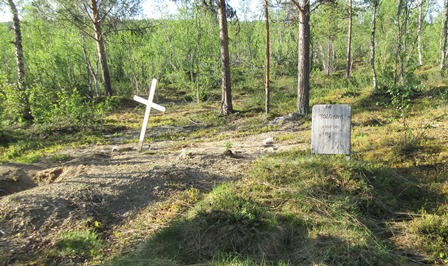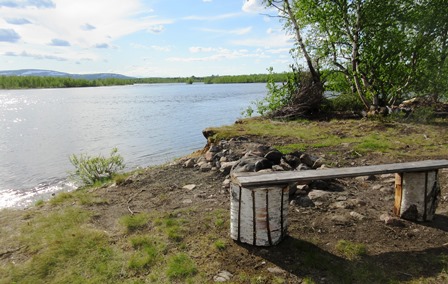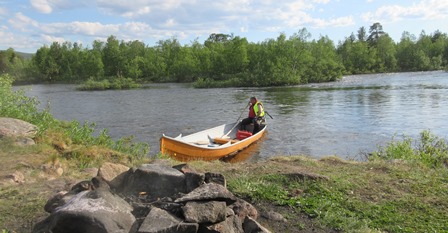There are two rivers near Kiruna, the Torne and the Kalix. People are less likely to visit the Kalix, meandering far away from roads between the mountains beyond Kiruna and the Baltic. Near Kiruna, though, you can get close to it. Along its banks are occasional buildings and small villages that sprang up in the early 19th century, from early Sami settlements on reindeer migration routes or when settlers came for the rich fishing opportunities there.
The river is wide and shallow in places, with small islands that force the water to flow faster either side. In these narrow channels the water refuses to freeze, even in the depths of winter. Many times this winter we’ve skied along the river’s frozen banks to a fishing hut. The views from there are wide, in one direction to the high mountains, and elsewhere over expanses of snow-covered ice and a few small areas of open flowing water where we could watch migrating birds gather.
Now in summer we’re exploring the river bank in an entirely different way – walking through warm or wet low birch forest down to the bank, stepping along narrow paths, seeing small wildflowers pushing their way through fresh greenery, water rushing at our feet and insects buzzing insistently in our faces.

Secrets
We’re looking for a new view of the river. Each day is a challenge to find out more about it and where it goes on each of its secretive turns through the forest. We suspect that eventually the path we’re on will lead to another part of the river bank, perhaps another fishing spot, where we hope for open space and a breeze to whisk away the troublesome insects.
It feels a secret world of unexplored richness. It’s not true of course, since we’re on some kind of narrow earth path which must be used by people going fishing, and is also evidently used by moose, who like to defecate as they walk. Moose poo is dry and straw-like and disintegrates under your foot into powder. We can’t see far ahead, but have a sense of where the river might be, beyond the wild growth.
Turning a corner we see a reindeer skull lying on the earth in a small clearing. Then we notice there are other bones, vertebrae, and another skull. Reindeer split from their herd become easy prey if they weaken. At first it seems rather unpleasant, but you get used to the idea – it’s the natural way of things. Corpses contribute to nearby wildlife, both animal and vegetable.

But it didn’t prepare us for the next sighting among rough bracken a distance away – a wooden cross. As we approached we saw there were two graves, and one of them had evidence of someone visiting the grave and leaving keepsakes.
At this point it feels very Scandinoir thriller. Had we stumbled on the scene of a crime? A crime of passion perhaps, a lover buried where he fell? Or maybe someone living off-grid, refusing the usual burial rites, buried and remembered by a friend? Rolf reminded me this is illegal in Sweden, and besides, if you had committed a crime you wouldn’t bury the victim in an area famous for fishing.

So we looked a little closer. Ah yes, just one name – Toscana (1980-1999) – and a small sketch of a horse. The grave was roughly horse-size. You couldn’t have dragged a dead horse here – it must have been buried where it fell. And the grave next to it – Isadora (1992 – 2018) – might have been a beloved dog, buried here to keep the horse company.
These are unexpected finds by the river bank.
Déjà-vu
Another day, and another exploration of the river bank. We quickly became tired of the insects and hoped the path would turn to the bank soon, exposing us to wind. It soon did and for a while we were stepping perilously close to the edge, clutching sticking-out roots to steady us along the river bank edge. The river here is wide and roaring, and we could see three or four islands, far out midstream, deliciously unreachable.
The path dipped away from the steep bank and down into an insect-ridden swamp before angling up again into more forest. Then the sun hit our faces as we emerged on a bend in the river, a wide clearing, a place for fishing. Firewood is provided by the community-spirited local fishing club, for anyone to use, and there are roughly made wooden benches to sit on round the fire.

The wind does the trick, freeing us from being bitten. We settle onto a bench and feel at peace, slowly taking in these new views of the river. Reaching a newly-discovered place we feel a sense of achievement, especially at it has been a little troublesome to get to it – as it almost always is.
As we’re sitting there my eye is drawn to a rather characterful birch tree, bent and scarred, clinging to the river bank just in front of me. As I look at it something feels rather familiar about it. The jagged tree and an island just beyond it – yes, familiar, somehow. I imagine the picture with snow and ice, change the dimensions of the river, and myself standing on skis on the ice, and I know we’ve been to this spot before.
On our ski trips we’d stop at this bend in the river to catch our breath and prepare ourselves for the cold wind coming round the corner, on the last stretch to the hut. Adjusting my hat and exchanging a few words with Rolf, I might look up at this gnarled old tree, high above us, half buried in snow, and wonder why I could see the exposed edge of a bench there.
I didn’t at all appreciate that that was where we were now. I thought we’d walked to another part of the river, an inlet along the way. But the more I look the more convinced I am.
It’s an unsettling but wonderful experience to discover a new place and then to learn that the new place is somewhere you’ve been many times before. To realise that a place can be so very different in another season, that really, it is a new place.
‘And the end of all our exploring
Will be to arrive where we started
And know the place for the first time.’
(from T.S. Eliot’s, ‘Little Gidding’)
In the Desert
You can approach the river bank in a number of ways but unmarked rough paths from the road may lead to a house, where you may not be welcome. One route we discovered provides the closest vehicular access to a number of far-flung properties, whose owners must leave their cars some distance from their homes and tramp further through the birch forest, but we were able to park at the access end of this road and walk in another direction towards the river.
On the way there something about the landscape felt strange. It was very open in places, when one would expect to find low birch trees. Usually this means bog land, which also means insects, and very likely a small river somewhere. The wetness breeds a variety of coloured moss and tiny low flowering shrubs, and the air had a strong smell of rich growth.
After the bog the path turned left and ahead of us was something entirely different. High sand ridges, interspersed with long low barren sandy valleys, the occasional birch growing defiantly every few metres. My informed companion was able to explain to me that these dunes were formed by the retiring ice during the end of the ice age, as rivers flowed under the ice shield and pulled sand into piles along the way. Subsequently this enormous supply of sand was used for building, it would have been a sand quarry. Despite this exploitation there was still something impressive about the large sand hills, and the contrast to everything around them.
It was a hot day, we weren’t expecting sand dunes, and we could have been hallucinating. Perhaps we were dreaming of a hot Mediterranean land, hearing the gentle trill of the cooling sea in the distance. Then we saw a group of reindeer, standing very still in the sand valley, antlers turned towards us. You could feel their heat. Reindeer like it cold, very cold – hot sandy beaches aren’t really their thing, you’d think. But they didn’t budge. In fact they settled in, a family group on the sand, sitting comfortably – as if to say, ‘why not?’ As if they were camels, not reindeer. Bizarre.

It was too hot and dry for us – we headed on to the river bank.
After spending a couple of hours by the river we packed up to walk back to the car. They were still there, the reindeer, on the sand. They looked at us quizzically. I imagined they wanted something, but couldn’t think what. We both wondered if we should find something to put water in, to bring to them, thinking they must be thirsty out there on the hot dry sand. Then we remembered they had legs, they could walk to the river.

It still seemed strange to see reindeer in sand, so when a bluebird swooped overhead it just added to the Disney quality of the scene. Then more dipping and rising birds appeared, flying up the sand valley. Not bluebirds of course, but sand martins, swooping in to the sand walls to their nesting holes and back out over the river to catch insects. The reindeer observed them, serenely, in the desert.
The Man in the Boat
We have a favourite spot on the Kalix River, winter and summer. It’s easy to reach, right by where the river is narrowed by islands, so in winter you get to see a bit of rushing water by the ice. There’s an official ‘resting place’ here, a hut provided for shelter, and a place to make a fire.
We like it because every time we come it looks a bit different. This time the river level was high, and the bank full of new green growth. We heard a roar from an engine and on the river saw a narrow local boat with an engine, hovering. We looked out to see what the matter was. Just a man, in a boat, looking at us. We got a feeling this wasn’t quite right but couldn’t say why. The man continued to hover, then drifted towards us to greet us.
It wasn’t was it? Could it be? Someone we met here five years ago, living nearby? He looked different, but then, it was five years – so did we. It could be the same man. We decided it was. A man we’d pulled out of the fire when he’d tumbled in, a little the worse of drink. He was good company nonetheless, and we remembered it as a happy occasion.
Now, here he was again, five years older, heavier, and, it seemed, still a bit drunk. We had a short exchange, and it was soon clear that this was a man who shouldn’t be out in a boat.
Just as we were wondering where this would all end, he tried to steer the boat to the river bank and in the course of this fell back in the boat and couldn’t sit up. The boat was stuck on a bank of stones, but the water flowed deep and fast between him and us on the river bank.
What to do? There was a brief confusing conversation. I imagined the next half an hour and none of the scenarios looked very good. Every time he tried to sit up the boat lurched precariously from side to site, threatening to tip a very drunk, overweight man into the fast currents.
Rolf can’t swim, so it was down to me to decide that someone (me) would have to go out there and stop him drowning himself. I didn’t want to do it – how would I help him, if I ever reached the boat? He was a big, heavy man and might even pull me down with him. I hesitated. Yet nor did I want to see him tip himself in the river so we then had to watch him float away, to certain drowning.
I began to wade out. When I felt the strength of the current round my thighs I realised I needed a branch for safety and Rolf went to look for one. It arrived, but floated downriver before I could catch it. The man was still on his back in the boat, but then he suddenly sat up, as if it was no problem at all. The prospect of the humiliation of being rescued by a woman might have given him the prompt he needed.
I came back to shore and we watched nervously as he tried to bring the boat in. Despite his inebriation, he was skilled with a boat, and so he got it to the river bank. Much relief. We then all sat together to reflect on life.
This went on for some time. He knew I was English, and used the few words of English he had to initiate a conversation about the secret ‘sense’ of women. Unfortunately we never found out what it was, because his conversation was circular, and he counted other human senses endlessly on his fingers, never getting to the point.
He described his intimate knowledge of this difficult stretch of river, and then had a bright idea. he would show us us how he could travel against the tricky current on the other side of the island, and return to this side without tipping over. Please – no! But before we could stop him he was back in the boat.
Immediately it got stuck on a bank of stones. We waited patiently as he tried to prize himself off. It made us feel anxious to watch, but we’d already witnessed that his past experience could shine through his drunken haze, so we waited hopefully. It took a while, but then he was off, and roared up the river like a man at the wheel on a racing track, playing to the crowds – in this case, just us. He did it twice, just to prove it wasn’t a fluke, and then zoomed back down the river and disappeared from sight.
His life always looks in danger when we see him. We hope his luck holds out and we’ll see him in another five years.


